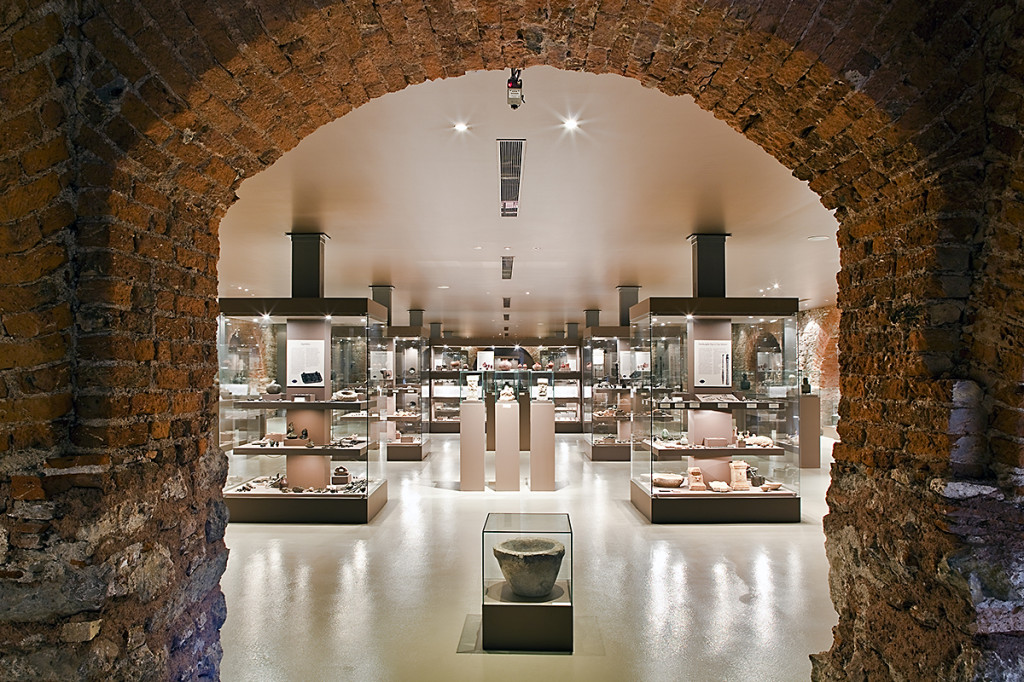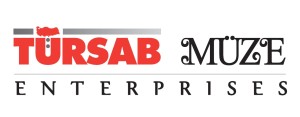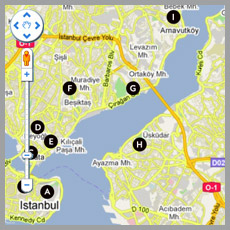By Elif Türkölmez
Rezan Has Museum opened its doors for the first time in 2007 through an exhibition of costumes designed of fabrics originating from the dates of the Ottoman Empire up to our present-day, organized under the title “Timeless Simplicity” within the framework of the 1st International Conference on Oriental Carpets. The museum continues today to reflect indeed the spirit of its first exhibition in its well-established and mature simplicity.
The museum is a bridge between the past and the present owing partly to its building combining a 17th Century Ottoman bath structure with an 11th Century Byzantine cistern. Its archaeological collection of artefacts originating from 9 thousand years ago onwards, was supplemented with the documents and objects belonging to the former Cibali Tobacco
and Cigarette Factory. Rezan Has Museum located on the campus of the Kadir Has University consists of two principal departments. The archaeological artefacts collection spanning a large time period from the Neolithic Age all the way to the Seljuk era is located at the museum floor. The second department, the multi-purpose events hall is hosting throughout the year, various thematic and genuine art exhibitions, in particular of Turkish painting art.
Golden Horn’s Favourite
The Golden Horn area has been undergoing an extensive re-structuring for a while. Significant investments were made to establish a series of museums and cultural centres there, in order to convert the area into a recreational zone for the holding of city festivals and special events. They focused particularly on the former factories, building cradles, shipyards, ship launch rails, electrical power plants, abattoirs located in the Northern part of the area. Now, the Northern part of the Golden Horn is in the process of being transformed into a cultural development area where historical buildings starting from the Istanbul Museum of Modern Art, “Tersane-i Amire (Maritime Arsenal and Dockyard of the Kaptan Pasha (Captain of the Sea), “Aynalıkavak Pavillion”, Rahmi M. Koç Industry Museum”, “Sütlüce Culture Centre” “Miniatürk” and “Silahtarağa Museum District” with their rich cultural heritagestand all along its coastal line. For the Southern coastal line of the Golden Horn, in
particular the district between Eminönü and Eyüp where almost all historical and cultural heritage of its port structure was destroyed, a concentrated activity similar to that of the Northern part did not take place. Although some important points of attraction such as Fener- Balat and Tahtakale are situated at the inner side, the southern coastal line of the Golden Horn remained poor in terms of cultural structuring other than Feshane-i Âmire”, “Women’s Work Library” “Zindan Han” and “Baba Cafer Zindanı”. The Golden Horn is being transformed into a “port museum”, so that it is necessary to develop also the Southern part through intensive activities similar to those performed for the Northern part. In this sense, the “Rezan Has Museum for Golden Horn Cultures” established and located inside the Kadir Has University is a very significant initiative and fills an essential gap within the framework of such an important strategic geography. Kadir Has University’s main building which was converted from Cibali Tobacco and Cigarette Factory by Kadir Has Foundation in 2002 has been granted the European Nostra Award in 2003 due to its extremely meticulous and comprehensive restoration and its contributions to the historical environment in which it is situated. The venue opened to the public as the Rezan Has Museum was established following the discovery of the ruins of a “hamam” dating back to the Ottoman era and a Byzantine cistern found underneath the historical factory building following the completion of its restoration.
Seferikos Cistern and Ottoman Hammam
The cisterns, the water reservoirs made of stone, were important structures within the water supply system of the city during the Byzantine period. The cistern located in the Rezan Has museum dating back to the late 11th century comprises 48 arches, 15 pillars and 20 columns. This structure having a square-like rectangular plan was built directly to accumulate water. After losing its function as a cistern, it was first used as the tobacco warehouse of the Cibali Tobacco and Cigarette Factory and then as a food provisions warehouse during the Iind World War. The marble platform and steam channels of the Turkish bath structure, on the other hand, are still in good condition. The museum hosts also a Kadir Has Memorial Hall where the work desk, books and personal belongings of the founder of the university are on display.
Ongoing exhibition: Come-in
Currently, the exhibition “Come-in: Interior Design as a Contemporary Art Medium in Germany”, investigating the connection between fine art and applied design is taking place at the Rezan Has Museum until 15 July. The exhibition is organized through cooperation between Istanbul Goethe-Institut, ifa (Institut für Auslandsbeziehungen e.V.), Kadir Has University and Rezan Has Museum. Renate Goldmann is the curator of the exhibition at which twenty-five artists, representing different artistic positions, show individual objects, sculptures, installations and videos. Daily opening hours: 09:00 – 18:00 (except holidays)
Who is Rezan Has?
Rezan Has, spouse of the wealthy Turkish businessman late KadirHas, was born in 1927 in Istanbul, as the second child of a mother from Istanbul and a father from Kayseri. Her mother Şehline Hanım was a member of the Yağcızade family from Istanbul’s Kanlıca neighbour-hood and her father was Germirli Mehmet Bey from a well-known Kayseri family. Her secondary education took place at the Kandilli Girls High-School. She married her husband Kadir Has in 1942. The couple lived in Adana between the years 1942-1960. Rezan Has firmly supported throughout all these years the business career of herhusband who started his commercial business life at a young age. In 1960, the family Has moved to Istanbul, where Kadir Has engaged in charity ac-tivities from 1980 onwards, emulating in this his own father Nuri Has. Rezan Has actively supported and participated in her husband’s social responsibility endeavours. The couple established several education and health institutions, both in Istanbul and Kayseri. Finally, themuseum founded within the perimeter of the Kadir Has University was named after Rezan Has.
This article has originally appeared in “Müze” Magazine, published quarterly with the contributions of the Ministry of Culture and Tourism. We would like to thank TÜRSAB Museum Enterprises for sharing this piece with Istanbul Digital Platform followers.




















